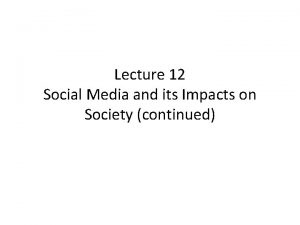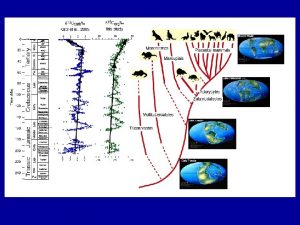Lecture 4 Megatrends Part II Social Humans are





























































- Slides: 61

Lecture 4: Megatrends Part II - Social

“Humans are perhaps the most successful species in the history of life on Earth. From a few thousand individuals some 200, 000 years ago, we passed 1 billion around 1800, 6 billion in 1999”[, and 7 billion by the end of this year (2012). Source: AAAS Atlas of Population and Environment (2000)


We have become a major force of evolution, not just for the "new" species we breed and genetically engineer, but for the thousands of species whose habitats we modify, consigning many to extinction; compelling others to evolve and adapt to our pressures. We have become a force of nature comparable to volcanoes or to cyclical variations in ? the Earth's orbit. Source: AAAS Atlas of Population and Environment (2000)

Thomas Robert Malthus • "The power of population is indefinitely greater than the power in the earth to produce subsistence for man" • An Essay on the Principle of Population, 6 editions published from 1798 to 1826. • Noted that sooner or later population gets checked by famine and disease

World Population Trends The world population increased from 3 billion in 1959 to 6 billion by 1999, a doubling that occurred over 40 years!

The annual increase in world population peaked at about 88 million in the late 1980 s. The peak occurred well after the annual growth rates were past their peak in the late 1960 s (because the world population was higher in the 1980 s than in the 1960 s).

Population Growth Rate Facts • 1700: 600 million >>> 2003: 6. 3 billion …. an order of magnitude increase. • 1927: 2 billion • 1974 (<50 yrs): 4 billion • 1999 (<25 yrs): 6 billion • Global Growth Rate peaked (2. 1%/yr) between 1965 -70.




Note: At the end of the 20 th century the world average population density was 45 people per square kilometer

The 1998 projections from the UN Population Division trace three paths, largely depending on how fertility changes. The medium projection assumes that countries with fertility above 2. 1 will not fall below that level, and countries with current fertility below 1. 6 will rise again to between 1. 6 and 1. 9. The low projection allows fertility to fall more rapidly, to a floor of 1. 6 in most countries, and to remain below that level where it is already below. The high projection assumes eventual stable fertility levels of 2. 1 to 2. 6 in all countries.

How current population Annual additions are Population growth rates -growth is perceived depends important as they show which determine the rate at very much on the datathe youtotal numbers of new which we must adapt our look at. Popular approaches human beings the planet technology and institutions to concentrate on total numbers must provide with avoid increasing (chart 1), which are important resources each year. environmental damage -- hit for our overall impact. These passed their peak their highest 35 years ago, show a curve getting steeper more than a decade ago, between 1965 and 1970, at from 1950 onwards, at 86 million a year in the 2. 1 percent a year. In the beginning to level out latter in 2050. half of the 1980 s. current decennium they are We are currently on the Currently they are runningprojected to average only 1. 2 steep section. at some 75 million a year. percent a year.

Age Distributions There will be a dramatic "population explosion" of older people. While the total population is projected to increase by only 40 percent between 2000 and 2050, the numbers of over-60 s will rocket by 232%

Many current changes may raise morbidity and mortality… • Antibiotics for example, lowered mortality rates, but there is concern that the spread of antibiotic-resistant bacteria may reverse this trend. • Fertilizer use made great headway in providing sufficiently nutritious diets to lower mortality levels, but the environmental degradation resulting from overuse is deteriorating water quality and so raising mortality levels. • Burning fossil fuels originally enabled a rapid growth in incomes, which improved nutrition, reduced mortality and accelerated population growth. But excess use of fossil fuels is driving global climate change, which may increase mortality by enlarging the zones susceptible to warm-climate diseases, and increasing the frequency of heat waves, storms, and flooding.

Adults and children estimated to be living with HIV, 2009 Total: 33. 3 million (31. 4 – 35. 3)

The number of people living with HIV has risen from around 8 million in 1990 to 33 million today (2008), and is still growing. Around 67% of people living with HIV are in sub. Saharan Africa.

Number of newly infected with HIV, 1990 - 2009

Global HIV trends, 1990 - 2009

Changes in the incidence of HIV infection, 2001 - 2009

Global prevalence of HIV, 2009

Annual AIDS-related deaths by region, 1990 - 2009

Other Health Indicators

The Trend of Urban Living

The world is becoming increasingly urbanized, rising from • 37% urban in 1970. • 61% (projected) in 2030. • Urban areas will see 95% of population growth between 1996 and 2030.

Megacities



Coastal Pollution Estimates show that almost 50% of the world's coasts are threatened by development-related activities.

Too many people in/near coastal regions? Katrina? Ike?

Clean Water • Clean water supplies and sanitation remain major problems in many parts of the world, with 20% of the global population lacking access to safe drinking water. • Water-borne diseases from fecal pollution of surface waters continue to be a major cause of illness in developing countries. • Polluted water is estimated to affect the health of 1. 2 billion people, and contributes to the death of 15 million children annually.

Increasing Water Issues • It is estimated that two out of every three people will live in waterstressed areas by the year 2025. In Africa alone, it is estimated that 25 countries will be experiencing water stress (below 1, 700 m 3 per capita per year) by 2025. Today, 450 million people in 29 countries suffer from water shortages.

Safewater Cartogram An area cartogram is sometimes referred to as a value-byarea map

Slums

Slum Living Increasing





Global Economic Trends The outlook for the world economy over the next 10 years is characterized by strong growth in almost all regions of the world. Impact on food imports and diet choices.

Global Economic Trends Economic growth in developing countries is projected to average more than 5. 6 percent annually during 2010 -19. This compares with average growth in developed countries of 2. 2 percent.

Consumption The per-capita consumption of key natural resources varies hugely around the world. Typically, but not universally, the citizens of rich industrialized nations use more of the world's resources and produce more waste. Sometimes they thereby deplete their own environments; sometimes other people's

Consumption q As population growth is slowing, consumption growth is emerging as the dominant factor increasing our pressure on the environment. Ø Between 1980 and 1996… • # of cars in the world increased from 320 million to 496 million, an annual growth rate of 2. 8 percent • # of TVs in the world grew from 561 million to 1. 361 billion -- an average of 5. 7 percent per year. Of this, the increase in television ownership levels accounted for 70 percent, and population growth for only 30 percent

FOOD CONSUMPTION A typical example is meat. China, with the world's largest population, is the highest overall producer and consumer of meat, but the highest per-capita consumption in the world is that of the United States. The average United States citizen consumes more than three times the global average of 37 kilos person per year


US Agriculture

US Agriculture

US Agriculture

US Agriculture

US Agriculture


Higher energy costs affect the agricultural sector more than the general economy. Energy-related costs are a relatively large share of non-farm input costs. Also, fertilizer prices will be up in 2001 due to high prices for natural gas, the major feedstock and boiler fuel in production of nitrogenbased fertilizer.

Economies at Risk

For the future of Africa, agriculture remains one of the most important issues. A majority of the population, especially outside urban areas, are involved in agriculture, and food security is one of the most important issues to solve in the short term in some parts of the region. The current financial importance varies, as presented in this map, with agriculture representing up to 50 -60% of the total economy in some countries (Guinea. Bissau, Central Africa, Ethiopia) and representing 20 -40% in Sub-Saharan Africa.

A Sloping Playing Field

Land Transformation We have transformed approximately half the land on Earth for our own uses • 11% each for farming and forestry • 26% for pasture • At least another 2 to 3% for housing, industry, services and transport • Area used for growing crops has increased by almost 6 x since 1700, mainly at the expense of forest and woodland.




Reading Assignment • Human Population Grows Up, Cohen (2005).
 Mikael ferm
Mikael ferm Ami bios manual
Ami bios manual American megatrends
American megatrends Pwc megatrends
Pwc megatrends Pigment granules in hair
Pigment granules in hair 01:640:244 lecture notes - lecture 15: plat, idah, farad
01:640:244 lecture notes - lecture 15: plat, idah, farad Social thinking social influence social relations
Social thinking social influence social relations Social thinking social influence social relations
Social thinking social influence social relations Social psychology lecture
Social psychology lecture Lecture about social media
Lecture about social media Addition symbol
Addition symbol Unit ratio definition
Unit ratio definition Brainpop ratios
Brainpop ratios What is a technical description?
What is a technical description? Describe the parts of a front bar
Describe the parts of a front bar The phase of the moon you see depends on ______.
The phase of the moon you see depends on ______. Part to part variation
Part to part variation Introduction of transport
Introduction of transport Teixits humans
Teixits humans Inbreeding in humans
Inbreeding in humans First human on earth
First human on earth Reproduction in humans
Reproduction in humans 23 chromosome pairs
23 chromosome pairs Family genus species
Family genus species Commensalism examples in humans
Commensalism examples in humans Three types of mutualism
Three types of mutualism Equity theory in organisational behaviour
Equity theory in organisational behaviour Gill pouches in humans
Gill pouches in humans Sexual reproduction in humans
Sexual reproduction in humans What is lytta virus
What is lytta virus Where did humans originate
Where did humans originate How fast do humans run
How fast do humans run Neutral mutation
Neutral mutation What is a beneficial mutation in humans
What is a beneficial mutation in humans Where does meiosis occur in plants
Where does meiosis occur in plants How many chromosomes in human
How many chromosomes in human Meiosis in testes
Meiosis in testes Phylum
Phylum Inherited traits and learned behaviors 5th grade
Inherited traits and learned behaviors 5th grade Do humans share 50 of their dna with bananas
Do humans share 50 of their dna with bananas Ingenuity of the humans
Ingenuity of the humans How do humans affect the water cycle
How do humans affect the water cycle What is codominance
What is codominance Pro genetic engineering
Pro genetic engineering Gene interactions
Gene interactions How many lower teeth
How many lower teeth Ozone layer depletion effects on humans
Ozone layer depletion effects on humans Examples of abiotic factors
Examples of abiotic factors About early humans for class 6
About early humans for class 6 The taxonomy of the domestic dog and humans
The taxonomy of the domestic dog and humans Desertification cause
Desertification cause Humans belong to which kingdom
Humans belong to which kingdom Taxonomic hierarchy of lion
Taxonomic hierarchy of lion Kingdom phylum class order of humans
Kingdom phylum class order of humans Post anal tail in humans
Post anal tail in humans Number prefix
Number prefix Chapter 34 circulation in humans concept mapping answer key
Chapter 34 circulation in humans concept mapping answer key Innate behaviors
Innate behaviors Where does cell mitosis occur in skin
Where does cell mitosis occur in skin Carbon is the building block of life
Carbon is the building block of life Pros and cons of gmo
Pros and cons of gmo How many chromosomes do humans have
How many chromosomes do humans have




















































































